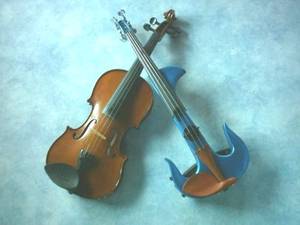The reputation of the famous Stradivarius and Guaneri names on violins has been dented by a new study showing that, in a blind test, musical professionals cannot tell the renowed instruments from modern counterparts.
In a trial published in PNAS and conducted, the authors report somewhat dubiously, in a hotel room at an international violin event in Indianapolis, 3 old violins dating from between 1700 and 1740 - two were Stradivarius and one was a Guaneri del Gesu model - were compared with three modern instruments built within the last few years.
 A panel of 21 professional musicians were asked to play each of the instruments and to rank the tone, playability, projection and response of the instruments, and also to pick out the ones they would most and least like to take home.
A panel of 21 professional musicians were asked to play each of the instruments and to rank the tone, playability, projection and response of the instruments, and also to pick out the ones they would most and least like to take home.
To avoid bias the participants were given welding goggles to wear to prevent them from picking up on any visual clues as to the age of the instruments they were playing, and the violins were further disguised with a blob of perfume applied to the chinrest to mask any olfactory giveaways.
Despite their combined $10 million price tag, which was over 100 times greater than the modern instruments, the violins rated least playable were those by the old masters. A Stradivarius was also the model most consistently listed as the instrument that the players would least like to take home with them. The assessors found no differences in the overall sonic performances between the old and new, however.
This is the first time that such a blind trial has been carried out and, albeit based on a small study sample, seems to suggest that the reputation of the greater masters' violins relates more to the price tag than the sweet music they make.
Indeed, as lead author Claudia Fritz from CNRS in Paris points out, "in a recent wine tasting experiment, it was found that increasing the stated price of a wine increased the level of 'flavour pleasantness' reported by subjects. Could," Fritz and her colleagues speculate, "a violinist's preference for a Stradivari violin be in part attributable to an awareness of its multimillion-dollar price tag and historical appearance, both of which may be signaled by its distinctive appearance?"
- Previous Explosive X-ray diffraction
- Next Trillion frames per second










Comments
Add a comment